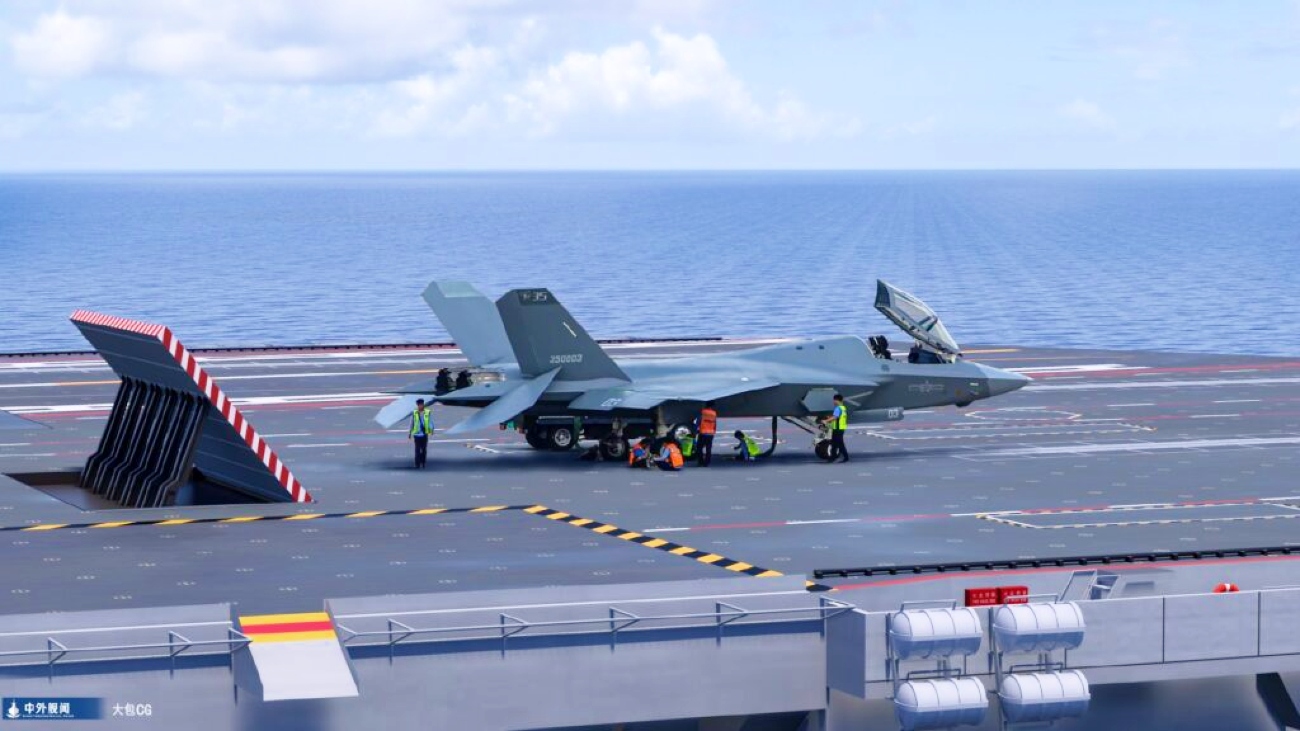On February 13, 2024, images began circulating on social media, suggesting significant developments in China’s J-35 carrier-capable fighter program. The photos depict what appears to be a mockup of the J-35 undergoing tests aboard the Liaoning aircraft carrier while in port for a scheduled overhaul.
The presence of the mockup on the Liaoning, China’s first aircraft carrier, indicates progress in integrating the J-35 into the country’s naval fleet.
This also raises the possibility of deploying the fighter on China’s existing carriers, which are not equipped with catapult launch systems but rely on ‘ski jump’ ramps.
The J-35 was originally anticipated to operate from the upcoming Type 003 Fujian aircraft carrier, utilizing China’s electromagnetic Aircraft Launch System. However, these latest developments suggest a different trajectory for the fighter program.
Both the Liaoning and China’s second aircraft carrier, the Shandong, operate on the short takeoff but arrested recovery (STOBAR) principle, utilizing ski-jump ramps for takeoff and arrester wires for landing.
The Liaoning, originally acquired from Ukraine, serves as the cornerstone of China’s carrier aviation ambitions, with the Shandong closely modeled after it.
大連にて整備中の空母"遼寧(CV16)"艦上にJ-35ステルス戦闘機のモックアップを確認。
モックはハンドリング試験用ですが今後遼寧艦載機となる可能性を示しており、以前から触れていた話ではありますが遼寧、山東の艦載機がJ-15からJ-15B及びJ-35に更新された場合は脅威度は跳ね上がることになります。 pic.twitter.com/Z3stuam05i— お砂糖wsnbn (@sugar_wsnbn) February 13, 2024
Both aircraft carriers, the Liaoning and the Shandong, have relied exclusively on J-15s for their fighter operations. These aircraft are Chinese adaptations of the Russian Su-33 Flanker carrier fighter, progressively enhanced with local modifications in engines, avionics, and weaponry.
However, the PLAN’s upcoming Type 003 Fujian (CV-18) aircraft carrier represents a shift. Unlike its predecessors, it adopts catapult-assisted takeoff but arrested recovery (CATOBAR) operations, with an advanced electromagnetic aircraft launch system (EMALS).
While the authenticity of the photos cannot be confirmed with absolute certainty, they offer enough detail to identify the mockup as a full-size representation of the J-35, commonly used for carrier compatibility tests.
Naval Defense Analyst Alex Luck retweeted the images on Twitter, commenting, “J-35 mockup on Liaoning. Indicative at best, but it would make sense given the two Kuznetsov carriers are unlikely to both be withdrawn before a meaningful number of CATOBAR CVs is in service.”

Moreover, Luck anticipates that in the long term, the J-35 will likely become the primary crewed fighter for carrier operations, while he believes that the service life of the J-15 series is finite.
He emphasizes that having additional decks for takeoff will not only facilitate operations but also ease the burden on related crew training pipelines, particularly in preparation for the deployment of the Fujian aircraft carrier.
J-35 Stealth Fighter
The J-35, referred to by experts as the carrier-based variant of the FC-31 or J-31 Gyrfalcon, represents a fifth-generation aircraft developed by China’s state-owned Shenyang Aircraft Corporation for the People’s Liberation Army.
In 2023, the Pentagon’s year-end report on the PLA noted that the J-35 conducted its inaugural flight in 2021. Tailored for naval operations, the baseline J-35 features refinements such as a heavily revised F-35B-style canopy and cockpit arrangement with limited rearward visibility, reinforced landing gear, and a catapult launch bar.
Additionally, folding outer-wing panels are incorporated to minimize its footprint while parked or maneuvering on the carrier deck.
Equipped with an advanced active electronically scanned array (AESA) radar, the aircraft is optimized for utilizing various Chinese-made air-to-air and air-to-ground ordnance.
In December 2023, a suspected mockup of the J-35 appeared on the deck of the Chinese Navy’s latest aircraft carrier, the Fujian. The fighter jet boasts stealth technology, positioning it as the Chinese counterpart to Lockheed Martin’s fifth-generation fighter, the F-35.
Recently showcased at the World Defence Show in Saudi Arabia, the aircraft is perceived by its manufacturers as a potential rival to fifth-generation US jets, which are favored by many countries in the region.
While the F-35 may have a lower maximum speed than the FC-31 at 1.6 Mach versus 1.8 Mach, it is recognized for its longer combat range of 1,240km (770 miles) compared to the Chinese jet’s 1,207km (750 miles).

In January 2024, Pakistan’s Air Chief Marshal Zaheer Ahmed Baber Sidhu announced plans for Pakistan to procure the FC-31 to modernize its air force. However, further details of the procurement were not disclosed.
That being said, the presence of a J-35 mockup on the Liaoning strongly implies that the People’s Liberation Army Navy (PLAN) is considering the feasibility of deploying the stealth fighter not only on the Type 003 carrier and its successors but also on the existing aircraft carriers.
- Contact the author at ashishmichel(at)gmail.com
- Follow EurAsian Times on Google News




